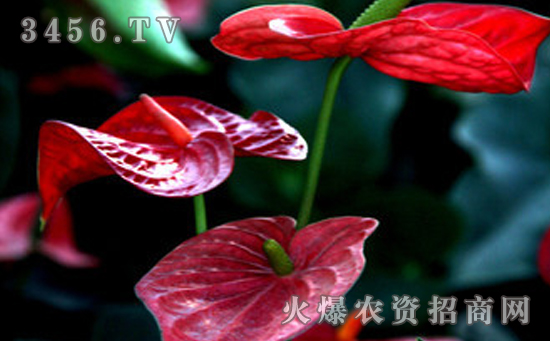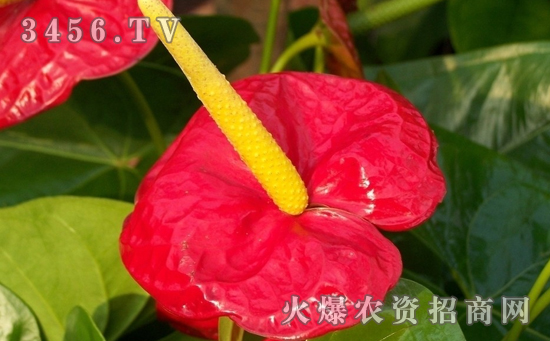How to control Anthurium andraeanum leaf mildew?
Anthurium andraeanum leaf mildew is caused by half-known fungi. The pathogen overwintered with hyphae or conidia in the diseased part or on the soil surface with the disease residue. It was weak parasitic bacteria, mostly secondary parasitic bacteria or saprophytic bacteria, which often appeared on the senescent leaves, and the plant expanded rapidly in the later stage of plant growth. In production, the initial number of bacteria and the conditions of temperature and humidity are often the decisive factors for the occurrence of the disease. If the air in the shed is clouded and the moisture retention lasts for a long time, the disease will be serious.
Symptoms: large gray spots on the leaf surface, irregular shape, obvious brown edge, expanding along the leaf margin, the size of 13 x 4 cm, the back of the leaf is grayish brown, the edge is dark brown, broad, slightly yellow halo, on which there are dark green mold piles and mold clumps, that is, the conidiophores and conidia of the pathogen. The disease often spreads upward gradually from the lower part of the plant, and sometimes the harm is more serious.
Prevention and control methods: ① thoroughly removed the diseased fallen leaves in late autumn and early winter and concentrated burning. Pay attention to ventilation and light transmission during the growing season of ②, and strictly prevent moisture retention. At the initial stage of the onset of ③, 50% carbendazim wettable powder was sprayed with 900x liquid or 65% carbendazim wettable powder 1000 times liquid, 50% Sukeling wettable powder 1500 times liquid, when the occurrence of serious, continuous prevention and treatment twice.
Control methods of Anthurium andraeanum Leaf mildew
Anthurium andraeanum is a flower that many people like. It was once regarded by people in Europe and the United States as a "warm" and "bold" feature. Anthurium andraeanum has good growth habits and is easy to cultivate, but if it is not managed properly and is prone to diseases, the common diseases of Anthurium andraeanum are leaf mildew and how to control it. Today, the editor will discuss with you.

Anthurium andraeanum leaf mold is mainly due to many diseased bodies, diseased leaves, poor ventilation and high humidity in planting greenhouse, which is beneficial to the occurrence of Anthurium andraeanum leaf mildew. The disease causes the leaves of Anthurium andraeanum to form large disease spots, and when the disease is serious, it causes the leaves to die.
I. Prevention and control symptoms and damage of red palm leaf mold
The disease spot mostly occurs in the leaf margin of Anthurium andraeanum. The disease spot is brown and irregular, and there is a yellow halo on the periphery of the disease spot; in the later stage of the disease, the center of the disease spot is light brown, and the edge of the spot is brown. Under moist conditions, dark green mildew spots appear on the disease spot.
2. characteristics of prevention and treatment of red palm leaf mold.
The pathogen overwinters on diseased leaves and diseased fallen leaves, and is spread by airflow, wind and rain.
3. Prevention and control of anthurium mildew
The main results are as follows: (1) cultivation techniques for disease prevention: thoroughly remove the diseased body and remove the senescent leaves in time; control the temperature and humidity in the growing season; it is forbidden to spray water directly on the plant clumps, water should be sprayed on the ground for cooling, and ventilation should be carried out frequently.
(2) Pharmaceutical control: spraying 1000 times of 50% prohydantoin wettable powder or 65% metamyl wettable powder, or 1500 times of 40 grams of chlorothalonil hot spray, or 1000 times of 50% carbendazim wettable powder, etc. About once in 10 days.
So much for the prevention and control of Anthurium andraeanum leaf mildew. Anthurium likes humid climate and warm environment. To prevent leaf mildew, Anthurium andraeanum should be kept cool, well ventilated and the soil should not be too barren. At the same time, the temperature of Anthurium andraeanum should not be too high, and the optimum temperature is 18 ℃-- 28 ℃.
Control techniques of Anthurium andraeanum Leaf Mold
Planting greenhouse has many diseased bodies, diseased leaves, poor ventilation and high humidity, which is beneficial to the occurrence of Anthurium andraeanum leaf mildew. Prevention and treatment methods include thorough removal of the disease, control of temperature and humidity, regular ventilation, chemical control and so on. The disease causes large disease spots on the leaves and causes the leaves to die when the disease is serious.
First, symptoms and harm:
The disease spot mostly occurs at the edge of the leaf. The disease spot is brown and irregular, and there is a yellow halo on the periphery of the disease spot; in the later stage of the disease, the center of the disease spot is light brown, and the edge of the spot is brown. Under moist conditions, dark green mildew spots appear on the disease spot.
Second, the characteristics of the disease:
The disease is a fungal disease caused by Cladosporium cladosporioides (Fres.) de Vries. The pathogen overwinters on diseased leaves and diseased fallen leaves, and is spread by airflow, wind and rain. Planting greenhouse has many diseased bodies, diseased leaves, poor ventilation and high humidity, which is beneficial to the occurrence of the disease.
3. Prevention and control methods:
The main results are as follows: (1) cultivation techniques for disease prevention: thoroughly remove the diseased body and remove the senescent leaves in time; control the temperature and humidity in the growing season; it is forbidden to spray water directly on the plant clumps, water should be sprayed on the ground for cooling, and ventilation should be carried out frequently.
(2) Pharmaceutical control: spraying 1000 times of 50% prohydantoin wettable powder or 65% metamyl wettable powder, or 1500 times of 40 grams of chlorothalonil hot spray, or 1000 times of 50% carbendazim wettable powder, etc. About once in 10 days.
- Prev

What is the reason why Anthurium does not blossom?
Anthurium andraeanum generally refers to large and small leaf candles. The main reason for not blooming for 3 years is that there is no maintenance and management according to its ecological habits. It is native to the rainforests of Colombia and likes the conditions of warmth, high humidity and scattered light. The optimum temperature for growth and flowering is 22-30 ℃, and the temperature is best kept relatively constant.
- Next

How to prevent anthracnose of Anthurium andraeanum?
The disease is caused by a semi-known fungal fungus of Colletotrichum. The pathogen survived the winter in the diseased tissue or basin with mycelium and conidia, carried out primary infection and re-infection with conidia, and spread by Rain Water sputtering and small insect activity. Usually warm and humid weather and ecological environment can easily cause the disease.
Related
- Fuxing push coffee new agricultural production and marketing class: lack of small-scale processing plants
- Jujube rice field leisure farm deep ploughing Yilan for five years to create a space for organic food and play
- Nongyu Farm-A trial of organic papaya for brave women with advanced technology
- Four points for attention in the prevention and control of diseases and insect pests of edible fungi
- How to add nutrient solution to Edible Fungi
- Is there any good way to control edible fungus mites?
- Open Inoculation Technology of Edible Fungi
- Is there any clever way to use fertilizer for edible fungus in winter?
- What agents are used to kill the pathogens of edible fungi in the mushroom shed?
- Rapid drying of Edible Fungi

